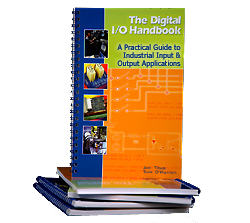The Digital I/O Handbook
The Digital I/O Handbook
A Practical Guide to Industrial Input & Output Applications
Read Featured Chapters, free online.

Digital I/O Explained
Renowned technical author Jon Titus and the President and CEO of Sealevel Systems, Tom O’Hanlan, clearly explain real-world digital input/output implementation from both a hardware and software perspective. Whether you are a practicing engineer or a student, The Digital I/O Handbook will provide helpful insight you will use again and again.
- Covers a wide range of devices including optically isolated inputs, relays, and sensors
- Shows many helpful circuit diagrams and drawings
- Includes software code examples
- Presents common problems and solutions
- Detailed glossary of common industry terms
“What I like most is its mix of hardware and software. Most pages have a bit of code plus a schematic. All code snippets are in C. This is a great introduction to the tough subject of tying a computer to the real world. It’s the sort of quick-start of real value to people with no experience in the field.” – Jack Ganssle, The Embedded Muse, January, 2005.
You can purchase the Digital I/O Handbook for $19.95 by clicking here. The Digital I/O Handbook is FREE with any qualifying Sealevel Digital I/O product purchase.
Click on a chapter title link below, to read that chapter. New chapters will be released monthly, starting with the first chapter in June, 2006.
- Introduction to digital electronics
- Current Sinks and sources
- Buffers and drivers
- Latches
- Negative and positive logic
- All in the family
- Introduction to output ports
- Simple on/off control
- Using drivers and buffers
- Relay basics
- Relays handle more power
- Optical isolation
- Solid state relays
- Control bits and bytes with software
- Introduction to input ports
- Basic TTL inputs
- Circuit isolation
- Current sinks and sources
- LED considerations
- Monitor high voltages
- Sense bits with software
- Flags
- Put it all together
- A final note about I/O ports
Chapter 4 – Sensor Interfacing
- Example 1: Thermal switch
- Example 2: Level switch
- Example 3: Hall-effect proximity switch
- Example 4: Photoelectric sensor
- Example 5: Shaft encoder
- Example 6: Output more than 8 bits
- Switch and Relay Configurations
Categories:
